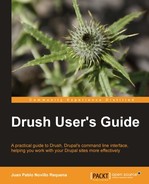Book Description
A practical guide to Drush, Drupal’s command line interface, helping you work with your Drupal sites more effectively with this book and ebook.
- Stop clicking around administration pages and start issuing commands straight to your Drupal sites.
- Write your own commands, hook in to alter existing ones and extend the toolkit with a long list of contributed modules.
- A practical guide full of examples and step-by-step instructions to start using Drush right from Chapter 1.
In Detail
Drush is a command line interface for Drupal. Most of the tasks for building and maintaining a website are repetitive and involve filling in forms on administration pages. The majority of these tasks can be achieved with a single Drush command, shortening the development and maintenance time of a project drastically.
Drush User’s Guide will allow you to be more productive and efficient in building and maintaining your Drupal sites through the command line. You will learn to install Drush on different platforms, and manage and configure your Drupal site by learning how to use and create Drush commands.
Become a Drush expert by exploring its command toolkit; customizing it to suit your needs, and extending it with contributed modules.
The command line will allow you to download, enable and upgrade Drupal projects in seconds. Back up your files, code and data in one single file, clear the cache, interact with databases, and deploy sites to remote machines – all using simply the command line. Use Drush with your own commands or alter existing ones; and extend the toolkit with a long list of contributed modules.
Drush User’s guide has everything you need to extend your use of the command line to easily build and manage your Drupal sites.
Table of Contents
- Drush User's Guide
- Drush User's Guide
- Credits
- About the Author
- About the Reviewer
- www.PacktPub.com
- Preface
- 1. Installation and Basic Usage
- 2. Executing Drush Commands
- Downloading and installing Drupal (site-install)
- Configuring a site (variable-set and variable-get)
- Working with projects (pm-X and user-X)
- Creating users and user roles
- Clearing out cached data and image styles (cache-clear and image-flush)
- Running cron (core-cron)
- Working with a site's database (sql-X commands)
- Backing up and restoring entire websites (archive-dump and archive-restore)
- Monitoring watchdog messages (watchdog-X)
- Summary
- 3. Customizing Drush
- Writing a custom command
- Altering and reacting to existing commands
- Executing custom PHP scripts
- Type less and do more with Drush Site Aliases
- Using configuration files
- Optimizing the terminal for Drush
- Summary
- 4. Extending Drush
